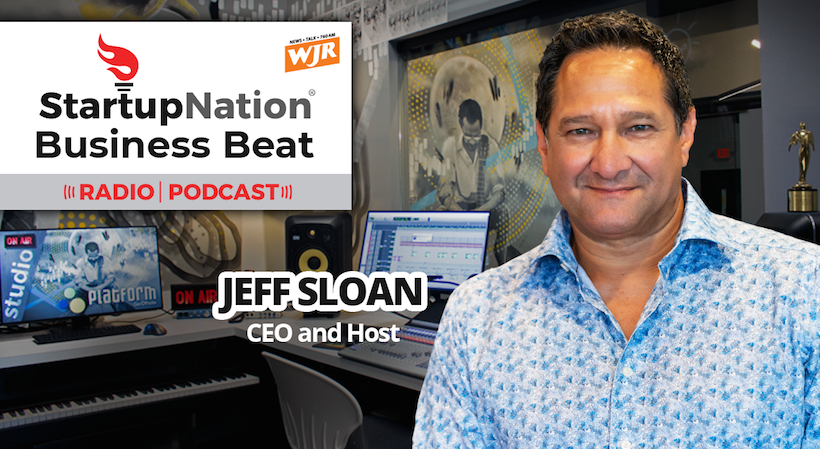StartupNation |
- 11 Tips to Master Self-Discipline and Rid Yourself of Bad Habits
- Have a Startup? Make Sure You’re On the Right Fundraising Path
- The Secrets of a Strong, Successful Cofounder Relationship
- StartupNation Growth Hacks #7: A Rare Hiring Opportunity
- Creating Vertical Social Networks for Niche Audiences: How This Startup Captured Millions Across the World
- WJR Business Beat: Tech Companies Seek Talent in Ukraine (Episode 384)
| 11 Tips to Master Self-Discipline and Rid Yourself of Bad Habits Posted: 30 Mar 2022 09:00 PM PDT
Warren Buffett said: "Chains of habit are too light to be felt until they are too heavy to be broken." It's far too easy for bad habits to derail our businesses, health, finances, relationships and happiness. Just one bad habit can be the bad apple that spoils a dozen good ones. Here's how top entrepreneurs and members of The Oracles mastered the self-discipline to break their worst habits and set themselves up for success. 1. Quit wasting weekendsI made a change at age 25 that transformed my life forever. I quit doing weekends like 99 percent of society. I stopped spending money I didn't have. I stopped drinking. I stopped smoking. I stopped trying to impress people. I stopped making excuses. Most importantly, I stopped lying to myself and operating below my potential. Instead of partying, relaxing, and kicking back, I got my hustle on and worked. This one habit saved me millions of dollars. I'm not saying you have to work every weekend. There are times and places for relaxation, but wasting every weekend was self-defeating. To break my bad habits, I simply made the decision that I wanted success more than temporary fun. So, keep your eye on the outcome: what will you gain by breaking this bad habit? When you decide to let go of your own worst habit, I promise you, it will change everything. —Grant Cardone, top sales expert who has built a $500 million real estate empire, and NYT-bestselling author of "Be Obsessed or Be Average," follow Grant on Facebook or YouTube 2. Seek out painTo break bad habits, start by conducting a 360-degree review with seven to 10 people whom you know best. Ask them what areas of your life and business are not working while giving them complete freedom to be brutally honest with you. Now go even further: ask them what behaviors of yours drive them crazy. You'll learn things about yourself you didn't know. You'll find the truth hurts. But better yet, that hurt will create action. You need that pain if you truly want to break bad habits. —Tom Ferry, CEO of Tom Ferry International, ranked the #1 Swanepoel Power 200 real estate coach, and NYT-bestselling author of "Life! By Design," follow Tom on Facebook and Instagram 3. Get clear on your whyI used to struggle with discipline until I got crystal clear on my "why" and purpose: teaching others how to create an extraordinary life and master their mind. Once I got clear on my life mission and why it was important, I set clear goals to make it happen. Every morning I wake up and read my mission and goals, so they're at the forefront of my mind — this helps me make clear decisions throughout my day and not create bad habits or distractions. Then each night, I answer these three questions in a journal. One: what went well today? Two: what could I improve? Three: what am I grateful for? Being aware of actions that work each day helps me reinforce good habits. I then make small adjustments to things I can improve so I can keep living an extraordinary tomorrow. —Michael Johnson "The Mojo Master," speaker and mindset coach for professional athletes and elite entrepreneurs; follow Michael on Facebook Related: Strategies on Perseverance From 6 Seasoned Entrepreneurs4. Find certaintyBad habits always originate from a lack of focus. Any bad habit I've created stemmed from being unclear of my objectives and intentions. Once I became certain of who I am and what I wanted, everything else materialized. My biggest tool to gain clarity is my journal. I emphatically track my progress daily, weekly and monthly for each personal and professional goal; this allows me to tailor each day based on the area of focus and my daily priorities. It's tough to develop bad habits when you're continuously monitoring and analyzing your progress. Consistent success requires routines and checkpoints to maintain your purpose in business, health, personal finances and relationships. The key is to discover which habits allow you to build momentum. —Moshe Malamud, serial entrepreneur, former owner of The Franklin Mint, and founder of the private jet service M2Jets; follow M2Jets on Instagram 5. Have a formulaIn physics, "momentum" refers to the quantity of motion that an object has, which depends on two variables: mass (how much is moving) and velocity (how fast it's going). The formula is: Momentum (p) = mass (m) * velocity (v) This basic formula helped me maintain discipline as my income increased. Conversely, most entrepreneurs habitually apply "Parkinson's Law" to their finances: expenses expand to fill the income available,meaning that as revenues grow, so do expenses and lifestyle. Using the momentum equation, the mass (m) is income, and the velocity (v) is your savings rate. For example, for every $100 you make, if expenses are $90, you could save $10 (or 10 percent). But if your income increases to $110 and you maintain the same expenses, you could save $20 (or 18 percent). The momentum formula will help you establish disciplined habits and accelerate you toward desired outcomes because it simplifies everything. —Tom Shieh, CEO of Crimcheck; connect with Tom on Facebook 6. Understand your triggersThe key to breaking free from bad habits is to find their source. So, identify the bad habit and then isolate its trigger. For many entrepreneurs, bad habits are merely caused by stress. To break the cycle, replace the bad habit with a positive one that provides a similar benefit. For example, I always turned on the TV the second I came home to relieve stress. This negative habit led to wasted time and procrastination — a feeling I despise. To counter this post-work stress relief, I began replacing my TV time with running. Because bad habits are a means of dealing with stress, we need to re-program ourselves to properly deal with stress. Eliminating your triggers requires extreme self-control and commitment but will lead to new, healthier behaviors that are personally and professionally more gratifying. —Jonathan Gilinski, serial entrepreneur, executive director of CapsCanada, and founder of Capsuline; Follow Jonathan on LinkedIn and Twitter 7. Plan for better onesAt 15 years old, I was huffing and puffing just to get through a one-mile run. It was years before I decided to adopt better eating and exercise habits. I started saying no to social activities that distracted me from exercise. I started saying yes to nutritious foods like lean proteins and vitamin-packed vegetables. Before I knew it, I was crossing the finish line of my first half marathon. This principle of planning better habits applies equally in business. When I work with new startups, I precisely map out the plan for victory. Then comes the hard part: follow through. To stay hyper-focused, I isolate myself from distractions during specific times. I switch my phone to "airplane mode." I only follow up on pressing matters. I focus on my plan. Adopt an unstoppable attitude, put one foot in front of the other, and keep going until you reach your goals! —Sweta Patel, founder of Silicon Valley Startup Marketing who has advised over 200 early stage startups and high-growth companies; connect with Sweta on Facebook and Instagram 8. Take actionIf your habit is truly is truly hindering your health, relationships, or success, get off your ass and do something about it! When quitting any habit or issue you deal with, remember: it gets easier every day that goes by. Be patient the first few weeks, and take mental control of the devil on your shoulder telling you the habit is necessary; it’s not necessary. The main thing to remember is this: 100 percent of bad habits are controlled by your mind. You will survive. Get professional help, read up on your habit, and know that you can master your mind to break it. This may take multiple attempts, but don't give up, you can do it! —Ken Lebovic, president of North Shore Holdings; built a real estate empire acquiring thousands of properties in 20 years with no equity partners 9. Prime your proactive mindsetIt's super important to get yourself into a proactive mindset instead of a reactive mindset. So often people wake up and start reacting to their day. When you're reacting, it's very easy to slip out of good habits and become less aware of what you're doing, especially if you are trying to build a new, better habit. For me, I take 15 to 30 minutes to myself in the morning to focus on my mindset and my goals. As I live on the beach, I like to take a walk, watch the sunrise with some good music on and visualize what I want to achieve that day and in general. —Jared Goetz, serial entrepreneur and e-commerce expert; cofounder of four multimillion companies in five years Sign Up: Receive the StartupNation newsletter!10. Community drives achievementWe all know that all progress starts with telling the truth. But when we share the truth publicly with a person or group — who can hold us accountable to do better — that's when we start seeing breakthrough success. I struggled with an irregular and unhealthy sleep-wake schedule for years until I started an accountability group daily call for 5 a.m. The 5AM Club changed my life by giving me the anchor I needed every morning, and today, we have hundreds of committed people on that call to start their days off right. Change happens in groups. —Sharran Srivatsaa, angel investor and president of brokerage (western region) at Douglas Elliman; grew Teles Properties 10X in five years 11. Pay the price todayWriting for The Oracles has kept me focused on breaking bad habits. I'm a creative guy, so I never used to enjoy looking at financial reports — it felt like getting a root canal. But finally, I forced myself to understand them. Break the bad habit mindset of "as long as I love what I do, the money will follow." Bullcrap. Now I live and die by the numbers, which has made me much more creative. It's hard doing the right thing all the time, but you can always be more honest with yourself by asking: Will this action take me toward my goal? Do the hard stuff first and get it out of the way. Otherwise, you'll always pay the price eventually. —Steve Griggs, founder and CEO of Steve Griggs Design; NYC's premier landscape designer transforming backyards and rooftop gardens into private getaways Originally published on CNBC.com. © 2017 CNBC LLC. All Rights Reserved. Originally published on startupnation.com on Jan. 10, 2018. The post 11 Tips to Master Self-Discipline and Rid Yourself of Bad Habits appeared first on StartupNation. |
| Have a Startup? Make Sure You’re On the Right Fundraising Path Posted: 30 Mar 2022 09:00 PM PDT
The following is adapted from “Exit Right: How to Sell Your Startup, Maximize Your Return and Build Your Legacy” by Mark Achler and Mert Iseri. Most of us know Travis Kalanick from his meteoric rise as the CEO of Uber, and his ultimate fall from grace. What most don't talk about is his obsessive focus on controlling his own destiny. He had a hard-earned fear of fundraising from his first two startup experiences, and it drove all of his decisions at Uber as well. At Uber, he and his partner, Emil Michael, played the game perfectly, wooing investors with their impressive traction. Uber went on to raise billions in capital, with a dual stock structure. While he left Uber with billions, Travis paid a heavy price in the decade before starting the company by not carefully managing his cap table. These are costly lessons to learn, and every founder should reflect on their own journey before committing to a decision to fundraise. Before Travis even knew what Uber would be, he solidified his approach to fundraising. He understood the value of a well-established plan as he moved forward in his new company. You also need this same understanding before you even think about fundraising, let alone an exit plan. Without it, you'll miss the opportunity to exit the right way, on your terms. To help get you started on the right path and ensure that you do not make an error early on that causes major ramifications in the future, consider the following four principles for fundraising early on in your journey. #1: Know thyselfYou should know what kind of business you want to build: a venture-backable business or a lifestyle business. A venture-backable business is a company whose business model and technology have the potential to generate significantly outsized returns—often 100x or more of the valuation of initial investment—fetching valuations above hundreds of millions of dollars. In contrast, a lifestyle business is a company whose business may be successful, even immensely profitable, but lacks the opportunity to scale above a certain threshold. This may be due to limits in the overall size of the market, growth obstacles around staff and automated systems, or lack of flywheel network effects. Many first-time entrepreneurs are blind to the important distinctions between these two types of businesses. Just because an entrepreneur is passionate about a given market, idea or product does not mean it will automatically be venture-backable. There are plenty of examples of companies who need capital to operate, but don't find venture investors to be a good fit for their long-term goals. No matter what you decide, you must protect your shares and treat them like the millions of dollars they will be worth in the future. Above all, make sure that whether you're a venture-backable or lifestyle business, you're staying true to your vision, goals and mission. #2: A change in ownership means a change in expectationsMuch of the startup media ecosystem is filled with headlines covering funding rounds and valuations. While the big numbers are flashy and intriguing, there is much more to fundraising than simply adding capital. It also adjusts the timeline of your future exit. The truth is if you raise money, you're shifting the ownership structure of your business. Many of the seed stage fundraising terms include preferred shareholders with liquidation preferences. These are the legal rights that determine how the payout from the sale will be distributed. With liquidation preferences, investors can take their money out first, and then the remaining funds are left for distribution. In addition, it is common to see board structures that favor shareholders instead of the co-founding team. This means that investors can decide to replace you, the CEO, if you disagree with their decision to sell. Conversely, if you are too tired to go on, but the company is on a growth path, the board and shareholders can similarly fire the CEO for someone with higher ambitions for their capital. This change in ownership comes with an implicit agreement and timeline for a liquidity event. Your new co-owner is going to want to come away with a return multiple on that investment on their time horizon, not yours. Must-Read: 5 Terms That are Killing Your Startup's Pitch |
| The Secrets of a Strong, Successful Cofounder Relationship Posted: 30 Mar 2022 09:00 PM PDT
Starting a company from the ground up is an exciting time. You have an opportunity to build a business from scratch and turn it into a legacy for your descendants. If you're an entrepreneur working with a cofounder, there are some things you can do now to ensure you have a long-term, successful relationship that brings both your dreams to life. Zippia took a look at the role of cofounders in U.S. businesses. It found approximately 45,730 people are working as cofounding entrepreneurs, with an average salary of $158.980. Not every startup with two founders succeeds, so taking some time to look at the ones that do can be helpful to newer companies. The Advantages, Challenges of Building a Multi-Founder Startup |
| StartupNation Growth Hacks #7: A Rare Hiring Opportunity Posted: 29 Mar 2022 09:00 PM PDT
The seventh in a series. The Great Resignation has left millions unemployed — by choice. The COVID-19 pandemic prompted workers to rethink what they wanted from their jobs. Given the leverage that employees have over corporate hiring these days, there are many highly qualified candidates who simply don't want to return to the traditional corporate 9-to-5 culture. Instead, they are looking for perks such as flexible work scheduling and a hybrid work-from-home arrangement, for example. And many of these prospective hires are even willing to trade compensation in order to have the perks they desire. So given that, who stands to benefit? You do! The small business community should be actively pursuing hiring opportunities. Let’s get to work!Hiring Trends to Counteract Today's Staffing Challenges |
| Posted: 29 Mar 2022 09:00 PM PDT
Of all the online innovations from the past 20 years, it is undeniable that the rise of social media is one of the biggest and most influential. The likes of Facebook, Instagram and Twitter have billions of users among them, and even those of us who aren't actively using any social networks understand what they are and how they function. Now, as we pass the 10th anniversary of Instagram, it is interesting to see the growth in popularity of alternative "vertical" social networks, in the form of creating new entrepreneurial opportunities: building platforms to meet the demands of those niche audiences with perhaps more specialized tastes and hobbies. One of the most important things to think about when launching a vertical social network is its initial purpose and timing. Ten years ago, the social media landscape was dominated by the big name players, however, more recently, their popularity has somewhat plateaued. The public has grown tired of ads swamping their feeds and grown evermore wary following the various data scandals that have embroiled these social media giants. Tap into a niche audienceOne issue with big social media is its broadness; losing relevance to, or even alienating, the groups that were once a platform's core users. There is no time like the present for smaller, more versatile players to build new networks celebrating "niche" audiences, catering exclusively to specific interests or needs. I would argue that social media has always had limitations when it comes to representing all interests and communities. The result is that the representation of more specialized hobbies and interests is left fragmented, sparse, and half-hearted in its drive to keep audiences informed and entertained. Conduct market researchAnother essential consideration for entrepreneurs looking to launch a social platform tapping into a niche audience is market research. It is imperative to learn about (and even live within) the field you want to build up with a digital product. One must spend a serious amount of time exploring those sectors, hobbies or groups that are underrepresented in the digital world. There are many sectors to tap into which still remain archaic and unchanged, but which deserve to join the wave of digitization, and evolve beyond that of a simple group on Facebook. In Fishbrain's case, there was an obvious gap that led me toward sport fishing and angling, a hobby that, despite being one of the most popular worldwide, had a limited representation online. Starting out with a small but talented team in Stockholm in 2012, we designed an app that provided anglers with a digital companion to help with multiple aspects of the fishing experience, from planning where to go to logging and sharing the latest catch. Our app has recently passed the significant milestone of 11.5 million users, with our most recent spike attributed, in part, to the growing number of people who understand the value of relevant vertical social networks, which platforms like Facebook, Instagram and Twitter are almost too big to cater to. By creating a social network for anglers (and this can be applied to any specific interest) we united a vast community of over 11.5 million people, allowing them to learn from each other, and connect with one another. After all, it is always more fun to share information, insights, tips and catches with people who have the same passions, as opposed to friends who might not. Related: How to Use TikTok for Business: 4 Key Steps as Told by a BrandCreate your own platformWhen you have selected your field, sufficiently researched it, and found the right time to launch, you must now look toward nailing the functionality of the platform itself. Don't be afraid to use what is there already. Take a lot of what works for "traditional" social networks and apply it to your own platform. For example, the ability to take, share and comment on photos. In my case, I saw that anglers loved to boast about their catches, but non-anglers might not want their news feeds crowded with images of caught fish. On a social network dedicated to fishing, these images will garner much more appreciation, feedback and "likes." You're not reinventing the wheel here, but instead trying to reach the right audience and establish yourself within an unconventional market. Sign Up: Receive the StartupNation newsletter!Use your dataOnce you start to grow, you will realize how much more your platform can be capable of in terms of growth potential and new functionalities. In my case, we realized our network could help do something more by raising awareness of industry issues, conducting vital research and learning from our own users.
We find that our users can contribute information and data in ways that are much more meaningful than simply generating revenue: they can provide information on unique environmental patterns, endangered species, preservation and much more. Really, the scope for useful and insightful data is vast. By crowd-sourcing information, you, as the network creator or provider, can develop features and information to benefit your users, which ensures that they stay with the platform for longer, and are more willing to contribute to it. For example, last year we launched a new feature that provides users with a forecast of the best times for catching a particular species of fish. We were able to do this because of the millions of catches logged on our platform. The information was right there in front of us: easily accessible and ready to be used in order to benefit our community. Key takeawaysWhat we view as "niche" social networks actually provide variety, insight and representation to consumers, at a time when the bigger players have fallen short. By creating tailored social spaces for a wide variety of interests and hobbies, I think we make the internet a better and more functional place. I would urge any entrepreneur to think about whether their industry needs a social network of its own: it will provide huge opportunities as a business venture, and a lot of enjoyment to the eventual end user it will serve. Originally published Dec. 4, 2020. The post Creating Vertical Social Networks for Niche Audiences: How This Startup Captured Millions Across the World appeared first on StartupNation. |
| WJR Business Beat: Tech Companies Seek Talent in Ukraine (Episode 384) Posted: 29 Mar 2022 08:00 AM PDT
Tune in to today's Business Beat to learn more about a program helping to get Ukraine’s tech talent through this challenging time:Tune in to News/Talk 760 AM WJR weekday mornings at 7:11 a.m. for the WJR Business Beat. Listeners outside of the Detroit area can listen live HERE. Are you an entrepreneur with a great story to share? If so, contact us at editor@startupnation.com and we'll feature you on an upcoming segment of the WJR Business Beat! Good morning, Paul! Against the backdrop of the horrific war going on in Ukraine, global tech firms are stepping up and lining up to hire Ukrainian programmers. You see, Ukraine has always been a hotbed for high-quality tech talent, in particular those who can write code known as programmers. What’s invisible to consumers is the programming that makes a given technology function as intended and surprisingly a large amount of tech that enables our everyday lives is built by engineers and software developers in Ukraine: WhatsApp, Grammarly, Get Lab and Salon were all founded or cofounded by Ukrainians, while Google and Amazon all have research and development centers in the country. And they’re there because of that uniquely capable and talented Ukrainian tech workforce to conduct programming in order to make these companies and their products go. As CNBC reports, companies from all over the world have posted job opportunities for programmers in Ukraine, on a website called Remote Ukraine. It’s been set up to help firms around the world hire these Ukrainian programmers and others. And this comes at such a critical time as some 2 million plus Ukrainian citizens have been displaced in the recent weeks. And some of them possess that amazing technical skill that can be put to work if given the right options. CNBC goes on to report that firms such as Modular Automation and War Ducks based in Ireland, Sport Trader based in Switzerland and others are among tech companies that have shared job opportunities on this site. Of course, it is all of our hopes that programs like this and others will help in any way possible to get the Ukrainian people and its great tech talent through this most challenging time. Just another example of the importance of the tech sector and how they’re supporting Ukrainian citizens at a moment in time when they need it most. I’m Jeff Sloan, founder and CEO of startupnation.com, and that’s today’s Business Beat on the Great Voice of the Great Lakes, WJR. StartupNation exclusive discounts and savings on Dell products and accessories: Learn more hereThe post WJR Business Beat: Tech Companies Seek Talent in Ukraine (Episode 384) appeared first on StartupNation. |
| You are subscribed to email updates from StartupNation. To stop receiving these emails, you may unsubscribe now. | Email delivery powered by Google |
| Google, 1600 Amphitheatre Parkway, Mountain View, CA 94043, United States | |







No comments:
Post a Comment